Shopify vs. WooCommerce: The Ultimate Comparison
- What is Shopify?
- What is WooCommerce?
- Shopify vs. WooCommerce: Quick Comparison
- Features
- Pricing
- Store design
- Extensions and plugins
- Payment methods
- Hosting solutions
- Search Engine Optimization (SEO)
- Ease of use
- Support
- Shopify vs. WooCommerce: Pros and Cons
- How to start dropshipping on Shopify?
- How to start dropshipping on WooCommerce?
- Dropshipping with BrandsGateway on Shopify vs. WooCommerce
- Should I use WooCommerce or Shopify for dropshipping?
- More platform comparisons
- FAQ
Shopify and WooCommerce are two of the most popular Content Management Systems (CMS) for building eCommerce websites. With Shopify powering over 4 million stores worldwide and WooCommerce supporting over 6 million active stores, both platforms offer an intuitive website-building experience.
In this article, we'll provide you with a comprehensive comparison between Shopify and WooCommerce and guide you through the differences and similarities of both platforms to help you make a decision on which one will best suit your dropshipping store's needs.
We'll go over:
- Main features
- Pricing plans
- Customization options
- Integration and third-party extensions
- SEO benefits
- Payment methods
- Hosting solutions
- Practicality of use
- Support team
Without further ado, here's everything you need to know about Shopify and WooCommerce before putting down your dropshipping business's roots.
:format(webp)/https%3A%2F%2Fbrandsgateway.com%2Fapp%2Fuploads%2F2024%2F06%2Fbanner.jpg)
Looking for a reliable dropshipping or wholesale supplier?
Join us today for top-quality products and unbeatable prices.
What is Shopify?
Shopify is an eCommerce platform designed for individuals looking to launch their online stores. With an easy-to-use interface, plenty of user-friendly features, affordable pricing plans, and no need for coding knowledge, Shopify is a fantastic option for building a professional-looking eCommerce business.

What is WooCommerce?
WooCommerce is an open-source eCommerce plugin created for WordPress stores. WooCommerce allows you to build an online store by providing you with tools to help you thoroughly personalize your website, showcase an unlimited number of products, and effortlessly manage your payment and shipping.
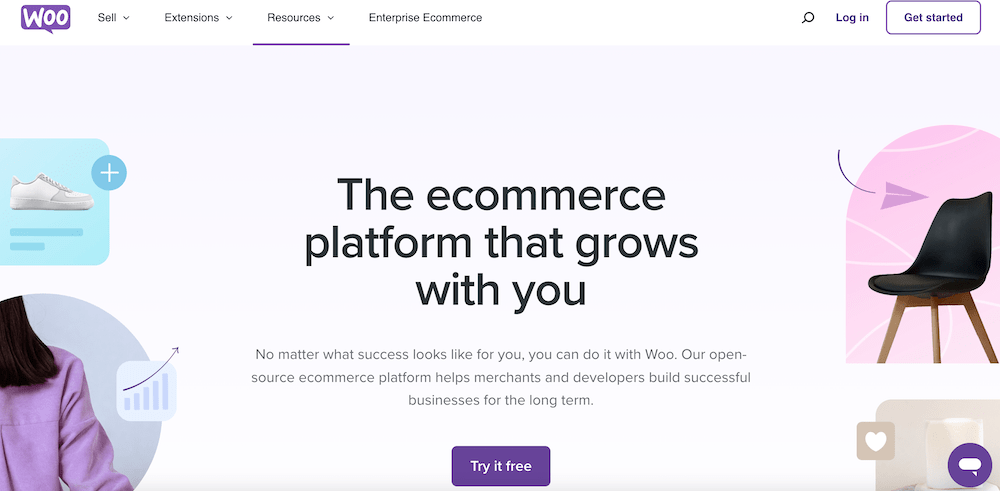
Shopify vs. WooCommerce: Quick Comparison
| Feature | Shopify | WooCommerce |
|---|---|---|
| Pricing | Affordable subscription-based plans: • Basic Plan for 32 USD/month • Shopify Plan for 92 USD/month • Advanced Pland for 99 USD/month | Free plugin for WordPress |
| Themes | +100 themes | +1,000 themes |
| Extensions | +1,200 plugins | +50,000 extensions |
| Payment Methods | PayPal, Amazon Pay, Apple Pay, Shopify Payments, Klarna, and more | PayPal, Amazon Pay, Apple Pay, Stripe, WooCommerce Payments, and more |
| Hosting Solutions | Built-in hosting service | Requires third-party hosting provider |
| SEO Tools | Built-in SEO features | SEO extensions Beginner SEO guides and articles |
| Ease of Use | User-friendly interface No tech skills required | Simplified web-building process Some customization may require coding skills |
| Support | 24/7 customer support via live chat, phone, and email | Support from the WooCommerce team and developers |
Features
Shopify features
These features are not available for all monthly plans, so this list can vary based on how much you are paying for your plan.
- Unlimited products. You can list unlimited products in your store.
- Staff accounts. Get access to multiple accounts for your staff members.
- Hosting solution. Set up your domain name easily within a few steps.
- Inventory locations. Operate multiple inventories simultaneously.
- Blog. You can run a blog on your website.
- Sales channels. Expand your reach by selling across various channels, including Amazon and eBay.
- Payment methods. Over 100 payment gateways are supported.
- Multi-language translator. There is an option to display your store in multiple languages.
- Shipping rates. The shipping and tax rates can be manually adjusted.
- Integrations. Works well with dropshipping app integrations.
- Free SSL certificate. Safeguard your store with a free SSL certificate.
- Reports. Access to statistics and reports on the performance of your website and products.
- Discount codes and gift cards. Discount codes can be created and added to cart totals for marketing purposes. Allows your customers to purchase gift cards.
- Cart abandonment recovery. Helps with recovering abandoned carts.
- Currency converter. Cater to international markets with an automatic currency converter for localized pricing.
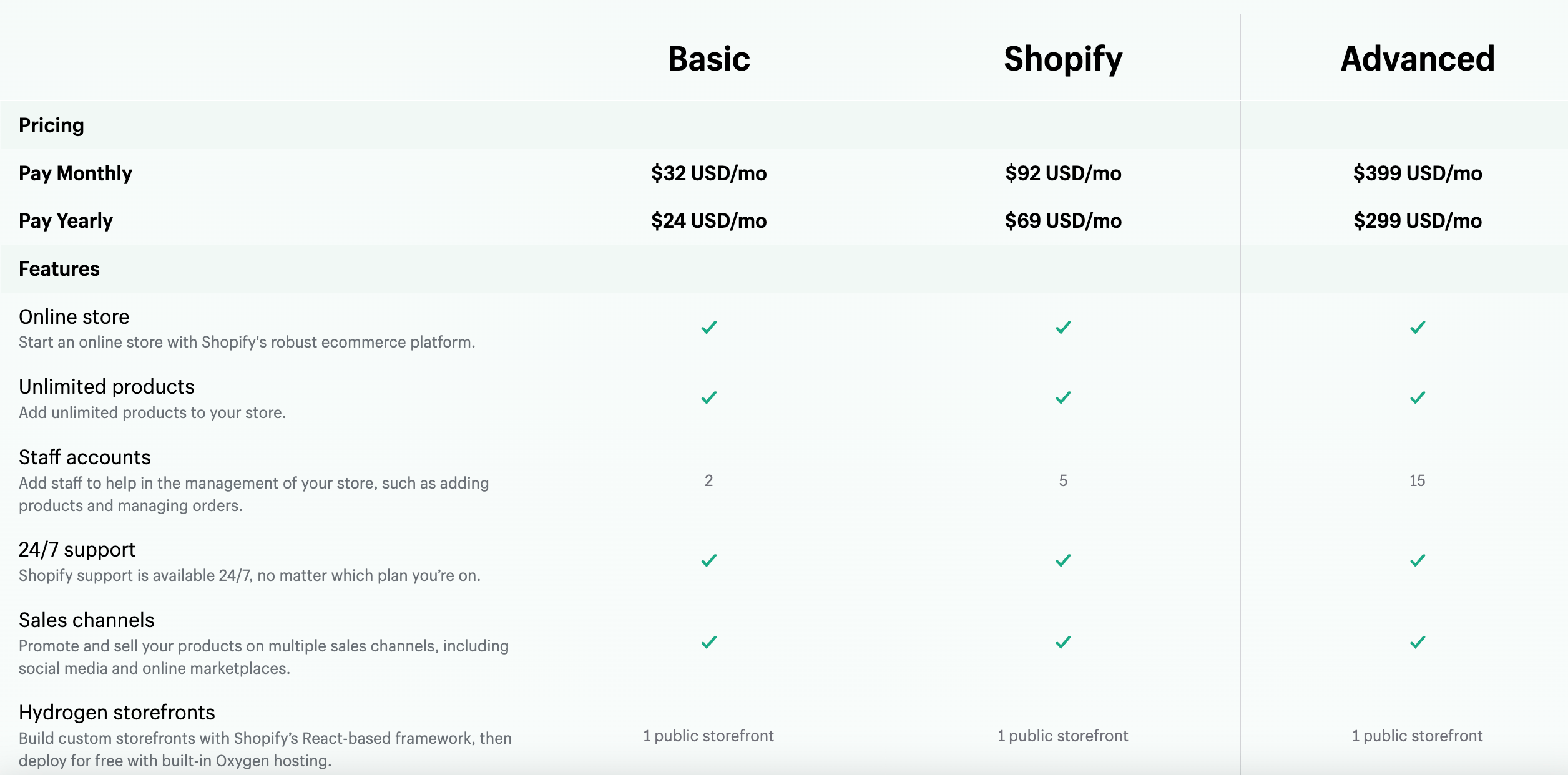
WooCommerce features
As a free open-source platform, WooCommerce puts the emphasis on extensions developed by third-party developers that you’ll likely have to pay for, but there are free features that are included automatically.
- Unlimited products. You can list and sell an unlimited number of physical and digital products.
- Themes. Choose from over 1,000 WooCommerce themes.
- Payment methods. Payments are accepted through PayPal, Amazon Pay, Apple Pay, Stripe, WooCommerce Payments, and others.
- Shipping options. Shipping and tax rates can be manually adjusted.
- Inventory management. Helps you to track your inventory and stock levels.
- Mobile–optimized. Offers a mobile-friendly structure.
- Third-party extensions and plugins. Over 300 extensions are available at your fingertip.
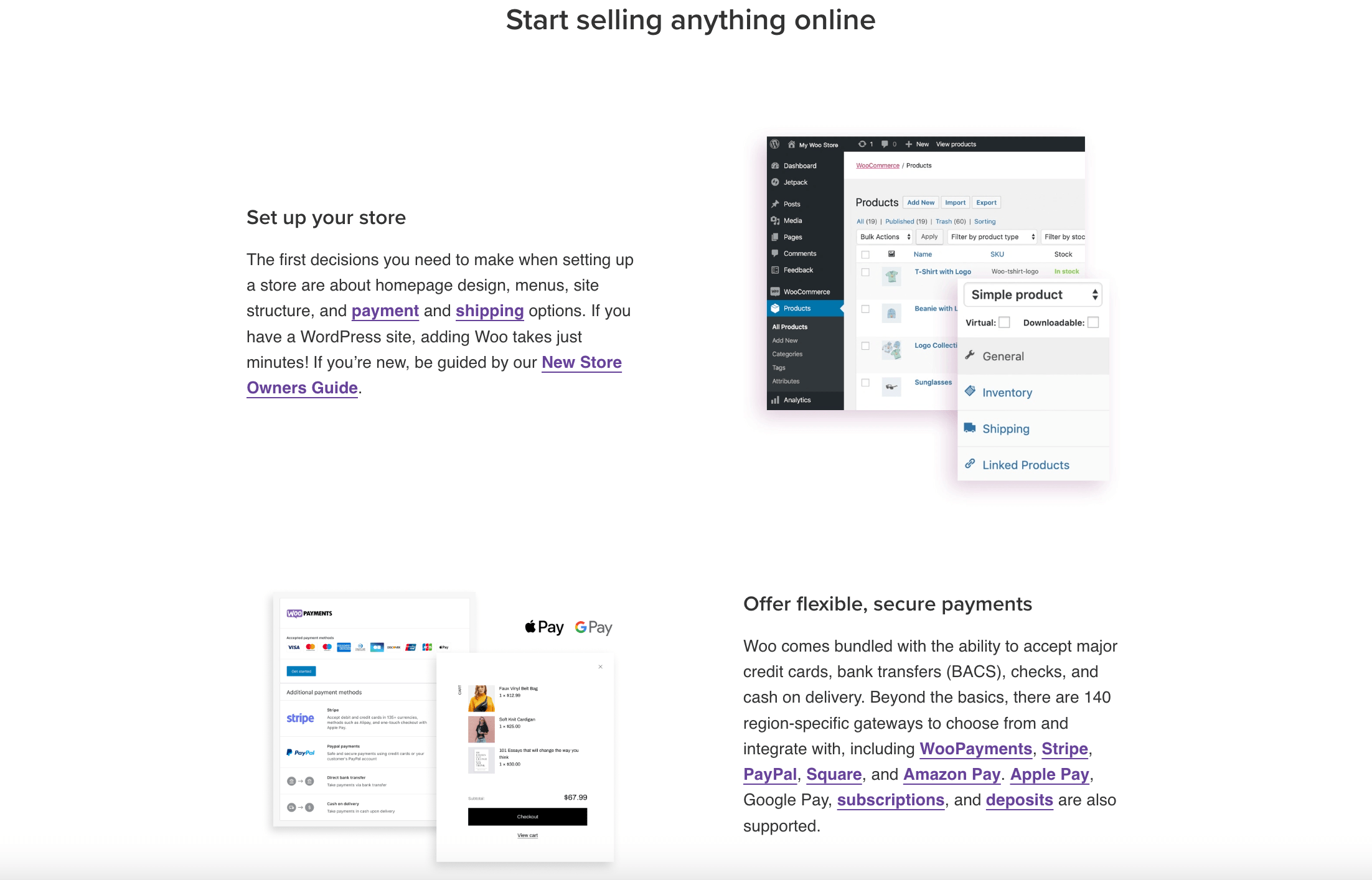
Key difference
Both Shopify and WooCommerce are quite similar when it comes to providing your eCommerce store with the essential features for selling your products.
Pricing
Shopify pricing plans
Shopify provides users with three subscription packages along with a free 3-day trial, allowing you to see how the platform functions and giving you time to set on a pricing plan.
- Basic plan – $32/month with 2.9% + 30¢ per online transaction – includes the majority of features listed above, it comes with two staff accounts and up to 1,000 inventory locations.
- Shopify plan – $92/month with 2.6% + 30¢ per online transaction – includes a more extensive list of features, allowing users access to five staff accounts, up to 1,000 inventory locations, and eCommerce automation.
- Advanced plan – $399/month – with 2.4% + 30¢ per online transaction – includes all features from the previous plans, enabling store owners to manage 15 staff accounts with 1,000 different inventory locations. In addition, users can also benefit from third-party calculated shipping rates and estimated duties and import taxes.
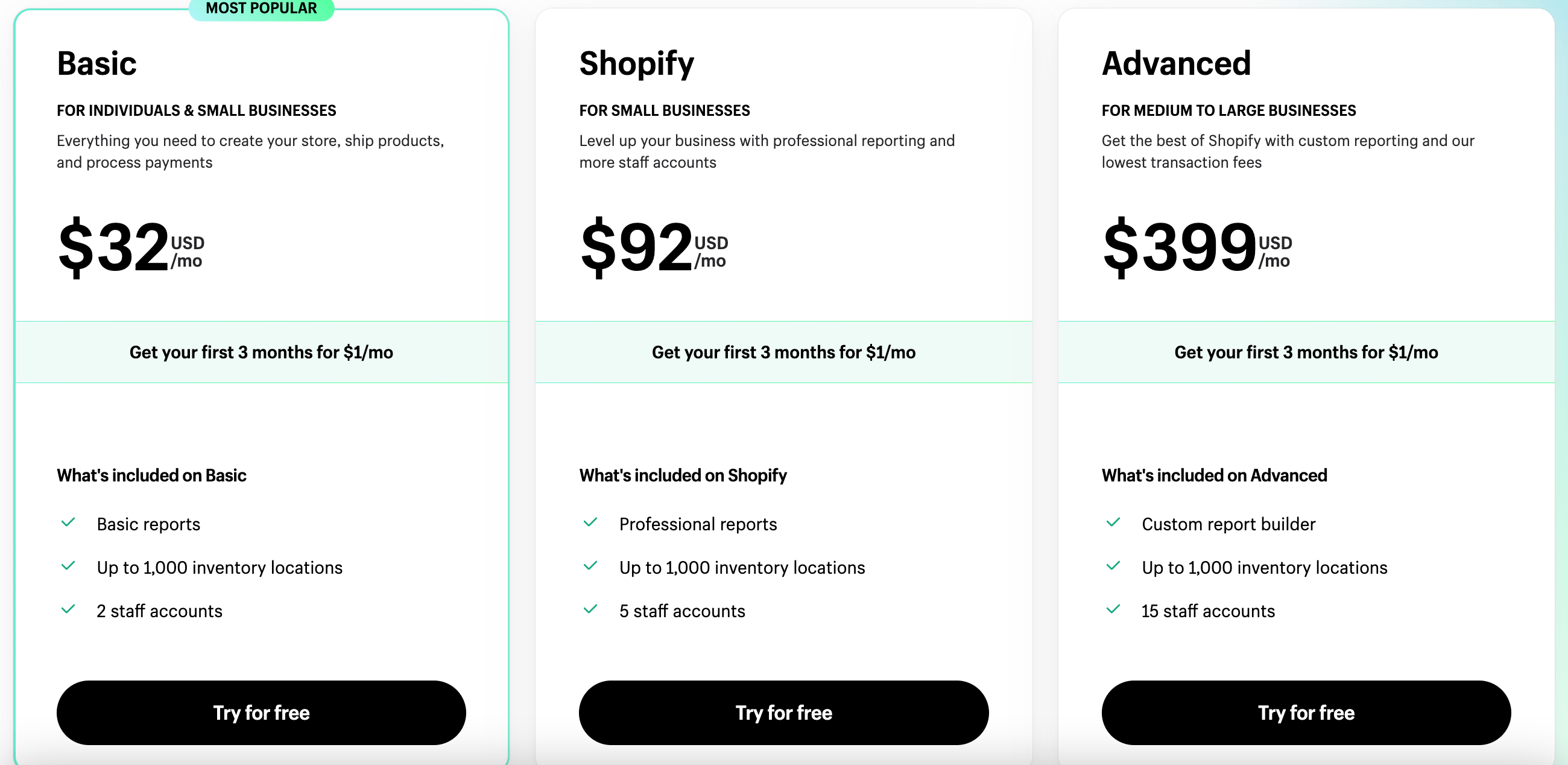
WooCommerce pricing plans
In the case of WooCommerce, setting up your store is completely free, but you will have to take care of hosting and security by yourself through a third party. You will also have to purchase:
- a theme;
- domain name;
- shipping and payment fees;
- WordPress subscription;
- other additional extensions.
At the end of the day, when the costs of running your website are added up on both platforms, it will likely come out to a similar amount.
Key difference
The platforms have different approaches to pricing. While Shopify’s pricing is based on subscription plans, WooCommerce is a free plugin available for WordPress stores, meaning your monthly expenses will vary based on multiple factors, including template costs, extension fees, WordPress subscription, and others.
Store design
Shopify store design
Shopify comes with a considerable number of web design features that provide an opportunity to create a stunning online presence:
- Shopify offers over 100 themes.
- Customers can find themes in different styles and color options.
- Price tags start at around 300 USD, with plenty of free templates available as well.
- All themes are created by experienced web designers.
- Templates are mobile responsive and fully customizable.
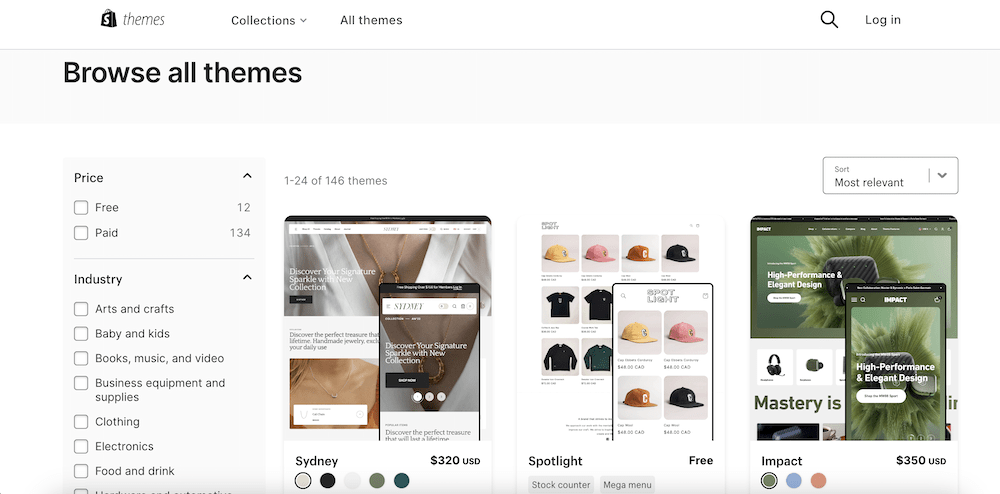
WooCommerce store design
WooCommerce comes with an extensive array of editing tools and customization options. This eCommerce plugin provides users with a wide range of design features to enhance their online store’s appearance and functionality:
- WooCommerce is compatible with the majority of the themes on WordPress.
- You can also choose from over 1,000 web templates specifically made for WooCommerce.
- You can find both free and paid themes, with the latter ranging from 20-300 USD/year.
- WooCommerce themes are completely customizable and can be custom-built by anyone with developer skills.

Key difference
When comparing the platforms’ design features, WooCommerce does come up on top by offering over 1,000 web templates. However, if you choose to go with more advanced customization, you might require assistance from a developer. Shopify, on the other hand, offers a smaller number of templates that are easier to get customized.
Extensions and plugins
Shopify extensions and plugins
When it comes to third-party extensions, Shopify-powered stores can benefit from:
- An extensive collection of around 1,200 plugins, accessible on the Shopify App Store;
- Plenty of free Shopify apps and affordable fee-based plugins;
- Extensions are available in different categories, including marketing, store design, finance management, product review, shipping and order fulfillment, and many more.
Check out: Best Shopify Apps for Dropshipping
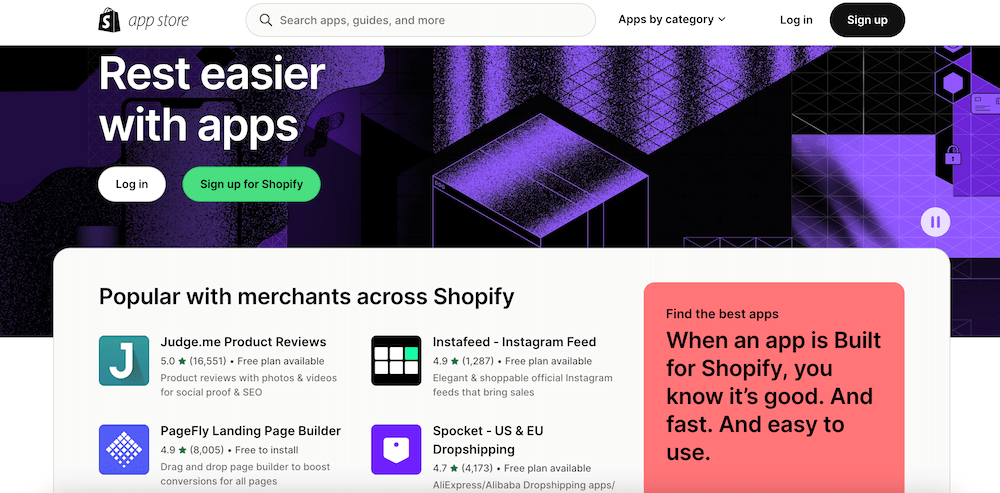
WooCommerce extensions and plugins
In the extensions and plugin section, WooCommerce provides users with the following benefits:
- WooCommerce provides you with over 50,000 extensions to choose from via the WooCommerce Extension Store.
- With WooCommerce being an open-source platform, anyone can release an extension for it.
- Both free and paid extensions are available, with prices ranging from $0 to $100 and more.
- Apps are available in different sectors, including marketing, social media, payment, store management, shipping, and customer service among plenty of others.
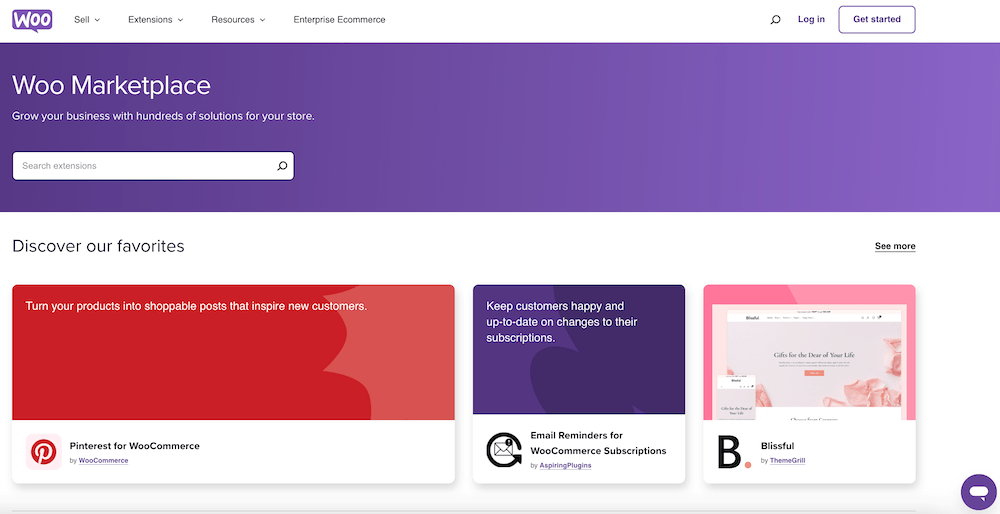
Key difference
Both platforms allow you to install plugins or extensions to enhance all areas of your business, such as email marketing apps, stock management, customer support apps, and SEO. However, WooCommerce offers the opportunity for anyone to create custom-built extensions. This also holds its risks because these extensions are not as well controlled as in the case of Shopify.
Payment methods
Shopify payment methods
Shopify allows store owners to choose from a variety of payment gateways they wish to use for making transactions:
- Shopify Payment
- PayPal
- Amazon Pay
- Klarna
- Stripe
- Square
- Verifone
WooCommerce payment methods
As previously mentioned, WooCommerce comes with plenty of payment methods you can use for making sales:
- WooCommerce Payments
- PayPal
- Stripe
- Apple Pay
- Amazon Pay
- Afterpay
- Square
Key difference
Both Shopify and WooCommerce offer a wide array of dropshipping payment gateways to select from, ensuring your customers will benefit from smooth checkouts.
Hosting solutions
Shopify hosting solutions
The great thing about Shopify is that it provides you with an in-built hosting service. You can buy your domain directly from the platform or connect an existing one you already have. On top of that, Shopify also provides all users with a forever free myshopify.com domain name.
WooCommerce hosting solutions
With WooCommerce operating as a WordPress plugin, it doesn’t offer hosting services. Users have the full responsibility to find a good hosting provider and set up their domain name. However, there are numerous hosting providers available to help with this technical aspect. Hosting platforms such as Hostinger, BlueHost, and HostGator stand out as excellent options, each offering SSL certificates for added security in internet connections.
Key difference
With Shopify, you can acquire your domain name directly from the platform, without needing to contact hosting providers. With WooCommerce, you’ll have to take care of setting up your web hosting by yourself. Nevertheless, a quick Google search will lead you to excellent and budget-friendly hosting platforms that can efficiently help you get your dropshipping store online.
Search Engine Optimization (SEO)
Shopify and SEO
Shopify will help you optimize your store for search engines by offering you:
- Built-in SEO features that include managing URLs, meta descriptions, title tags, image alt text, and more;
- Automatically generated sitemap;
- Benefit from URL personalization;
- Get access to free eCommerce SEO tutorials.
Check out: Best Shopify SEO Practices

WooCommerce and SEO
With WooCommerce, you can elevate your website’s ranking with an array of SEO-enhancing elements:
- Plenty of SEO extensions;
- Beginner SEO guides;
- Introductory SEO articles.
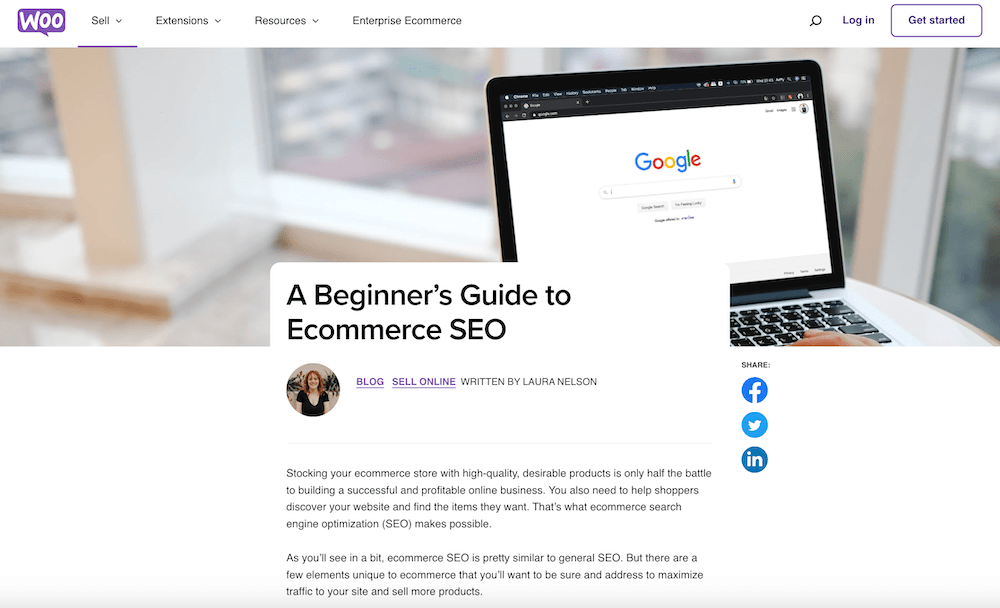
Key difference
When it comes to SEO on Shopify and WooCommerce, it is hard to tell which platform performs better as both can help your store to appear on the first page of search results. Both platforms allow you to build an eCommerce store with SEO-optimized code. Also, both offer a wide range of extensions and apps for you to be able to dig deep into metadata, customize URLs, and scan your site to see the places for improvement.
Ease of use
Shopify ease of use
Shopify is an ideal solution for eCommerce beginners. Users work with an extremely easy-to-use interface and an abundance of features that enable them to create an online store without needing any kind of tech-savvy skills. All in all, Shopify provides entrepreneurs with quite a straightforward website creation that doesn’t require hours to create and launch an eCommerce store.
WooCommerce ease of use
WooCommerce also provide users with a very simplified web-building process. While some customization may require for software and coding skills, WooCommerce still remains highly accessible for entrepreneurs with no developer knowledge as well.
Key difference
When it comes to ease of use and practicality, both platforms have their strengths and weaknesses. WooCommerce offers users good flexibility in terms of design customization, which sometimes might call for software and coding skills. Shopify provides customers with as great but slightly smaller flexibility, however, the platform doesn’t require users to have any previous tech knowledge and everything is taken care of for them.
Support
Shopify support
Shopify is known for its world-class customer support, available 24/7 either by live chat, phone, or by email. In addition to that, users can also access a great knowledge base through the Shopify Help Center, where they can find articles on how to start, manage, market, and expand their eCommerce stores. On top of that, you can make use of the Shopify community where they can interact with fellow entrepreneurs.
WooCommerce support
As a WooCommerce user, you can receive help from both WooCommerce’s support team or other developers by reading through or asking a question on WordPress’s forum. Alternatively, you can check out the WooCommerce Help Desk and benefit from the WooCommerce forum community. Moreover, there are always plenty of insightful blog articles in the WooCommerce blog section and a vast choice of guides and tutorials in the WooCommerce Documentation section.
Key difference
Both Shopify and WooCommerce offer plenty of customer support options, including the opportunity to get into contact with a customer representative member and consult educational materials.
Shopify vs. WooCommerce: Pros and Cons
Pros of using Shopify | Cons of using Shopify | |
|---|---|---|
| ✅ All-in-one eCommerce solution ✅ Affordable pricing plans ✅ Access to thousands of apps ✅ Numerous customizable themes ✅ Website hosting ✅ Quick store launch | ❌ Limited customization compared to other platforms ❌ The majority of templates aren’t free. | |
| Pros of using WooCommerce | Cons of using WooCommerce | |
| ✅ Free open-source plugin ✅ Complete store customization ✅ Thousands of extensions and themes ✅ Easy setup with WordPress ✅ Hundreds of store templates | ❌ Additional expenses for high-quality themes and plugins ❌ Doesn’t provide a hosting service ❌ In some areas, you might find yourself needing to learn some basic developer skills | |
How to start dropshipping on Shopify?
Follow these essential steps to kickstart your eCommerce journey with Shopify:
- STEP 1: Create a Shopify account.
- STEP 2: Personalize your online store.
- STEP 3: Set up a domain name.
- STEP 4: Provide your payment options, delivery methods, store policies, and sales channels.
- STEP 5: Connect your store with your supplier.
- STEP 6: Import your products.
- STEP 7: Start selling.
Check out: Ultimate Guide on Dropshipping with Shopify.
How to start dropshipping on WooCommerce?
To start dropshipping with WooCommerce, take a look at the following steps:
- STEP 1: Secure a domain with a reliable hosting service.
- STEP 2: Create your WordPress account.
- STEP 3: Customize your website design.
- STEP 4: Install the WooCommerce plugin.
- STEP 5: Configure your payment methods, shipping and return policy, and other relevant setups.
- STEP 6: Add necessary extensions.
- STEP 7: Connect your store with your supplier.
- STEP 8: Import your products.
- STEP 9: Start selling.
Check out: Ultimate Guide on Dropshipping with WordPress.
Dropshipping with BrandsGateway on Shopify vs. WooCommerce
Choosing an eCommerce option that allows a high-level integration with your dropshipping supplier is extremely important when planning on tapping into the dropshipping industry. Leading suppliers like BrandsGateway will offer you automated integration with the most commonly used eCommerce platforms, including Shopify and WooCommerce.
When dropshipping with BrandsGateway, you can benefit from:
- Access to a large catalog of over 20,000 luxury designer items and more than 100 brands;
- Collections of designer clothing, footwear, bags, jewelry, accessories, watches, and sunglasses, to name a few;
- Automated dropshipping which includes automatic inventory updates and order processing;
- Seamless bulk import of products;
- Full control over setting up your desired profit margins;
- Automatic conversion of currencies.
Dropshipping with Shopify and BrandsGateway
For Shopify-based stores, BrandsGateway has developed a unique Shopify App you can conveniently install from the Shopify App store and connect your store with BrandsGateway in only 6 steps:
- Register as a customer at https://brandsgateway.com/register/;
- Open the BrandsGateway App for Shopify;
- Select ‘Add App’ and install it in your Shopify store;
- Select your dropshipping package;
- Import the BrandsGateway catalog;
- Start making sales.
Dropshipping with WooCommerce and BrandsGateway
The WooCommerce integration is supported by a plugin that you can download and integrate into your store within a few simple steps:
- Register at https://brandsgateway.com/register/;
- Choose your dropshipping package;
- Install the BrandsGateway WooCommerce plugin;
- Create API keys for your store;
- Connect your store with BrandsGateway;
- Import the BrandsGateway products;
- Start selling.
Should I use WooCommerce or Shopify for dropshipping?
Depending on your business’s needs, both Shopify and WooCommerce are more than decent web-building platforms, offering remarkable sets of features that enable you to create a captivating and fully functional online store.
Shopify’s pros include its all-in-one solution, clear pricing, and extensive app store. WooCommerce offers complete customization, thousands of extensions, and a free plugin.
Deciding on the winning eCommerce platform depends entirely on your individual preferences and how well it aligns with achieving your store’s objectives.
So, the choice is yours to make. Whatever platform you go with, know it’s going to be the right choice.
More platform comparisons
FAQ
-
If you seek for a hustle-free way to enter the dropshipping industry, Shopify is an excellent choice. With an easy-to-navigate interface, plenty of integration options, convenient customization options, beautiful design templates, and an abundance of built-in features, Shopify provides an effortless way to launch and expand your dropshipping business.
-
Yes, WooCommerce is another solid option for building a successful dropshipping store. As a WordPress plugin, it offers an impressive flexibility and customization features, allowing entrepreneurs to create and run their dropshipping stores with ease, while benefiting from various extensions, plugins, and themes.
-
The choice between Shopify and WooCommerce depends solely on your store’s specific needs and preferences. If you prioritize an all-in-one solution and no need of coding whatsoever, Shopify may be better. For those seeking more control, customization, and have WordPress experience, WooCommerce could be the preferred option.
-
In general, Shopify is considered to be slightly easier to use than WooCommerce, especially for beginners. Shopify’s free hosting solution, drag-and-drop option, and pre-built templates simplify the process of setting up and managing an online store without requiring any technical knowledge.
-
The primary difference lies in the platform’s nature. Shopify is an all-in-one platform with pre-built designs and a hosting solution, while WooCommerce is a plugin for WordPress that offers bigger freedom in customization on a self-hosted WordPress site.
-
These platforms present some of the most excellent choices for eCommerce platforms:
- Shopify
- WooCommerce
- Wix
- Shift4Shop
- Magento
- Volusion
- Square Online
- Squarespace
Learn about other alternatives in our article on Shopify alternative platforms.
Related articles
Our clients' success stories speak volumes about the impact BrandsGateway has had on their businesses.
View More Articles








:format(webp)/https%3A%2F%2Fprod-brandsgateway-images.s3.fr-par.scw.cloud%2F2022%2F04%2Flilla-087c0e93-1f4.webp)
:format(webp)/https%3A%2F%2Fprod-brandsgateway-images.s3.fr-par.scw.cloud%2F2022%2F03%2Fonline-store-pricing-96cb60cd-147.jpg)
:format(webp)/https%3A%2F%2Fprod-img.s3.fr-par.scw.cloud%2F2024%2F01%2Fwoocommerce-vs-bigcommerce-ea5da1e3-968.png)
:format(webp)/https%3A%2F%2Fprod-brandsgateway-images.s3.fr-par.scw.cloud%2F2020%2F10%2Fdropshipping-high-ticket-bc5e5a14-acd.jpg)
:format(webp)/https%3A%2F%2Fbrandsgateway.com%2Fapp%2Fuploads%2F2025%2F04%2Freview-scaled.jpg)
:format(webp)/https%3A%2F%2Fprod-brandsgateway-images-do.s3.fr-par.scw.cloud%2F2019%2F04%2F6-Best-Men%E2%80%99s-Clothing-to-Sell-in-2019.jpg)
:format(webp)/https%3A%2F%2Fprod-brandsgateway-images.s3.fr-par.scw.cloud%2F2022%2F02%2Finstagram-stories-dropshipping-store-c7eaad24-d54.jpg)
:format(webp)/https%3A%2F%2Fbrandsgateway.com%2Fapp%2Fuploads%2F2025%2F03%2Fstartup-costs-scaled.jpg)
:format(webp)/https%3A%2F%2Fbrandsgateway.com%2Fapp%2Fuploads%2F2025%2F03%2Fgiveaway-scaled.jpg)